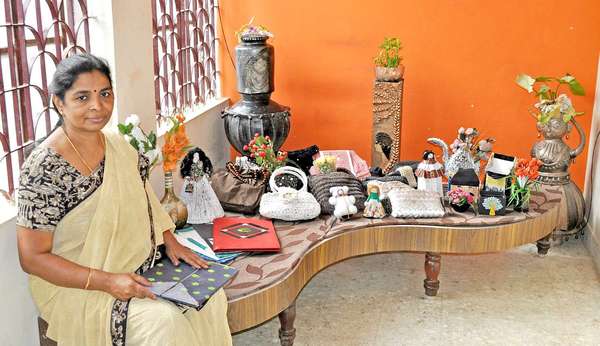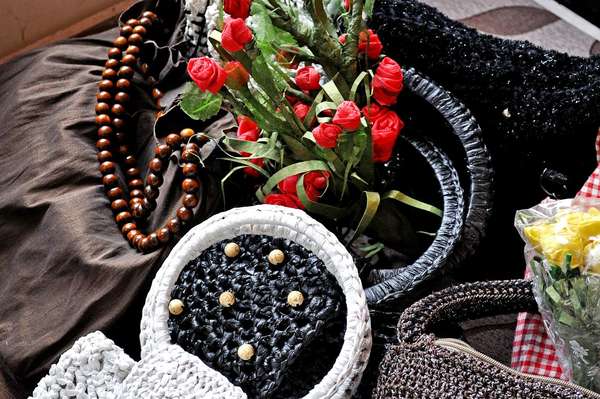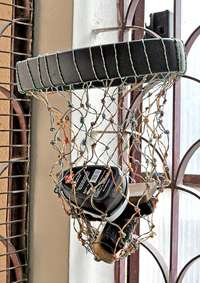Dakshayani Rama Chandran with her assortment of recycled objects. Pic: Kedar Nadella
“For me, nothing is a waste,” declares Dakshayani Rama Chandran, who lives in a silent side lane of the 5th Cross, Malleshwaram, away from the hustle and bustle of the main streets. She is someone who is deeply concerned about the waste that is generated around us each day. She believes that as responsible citizens everyone can do their bit to reduce the garbage that accumulates in the city.
The wallpaper on her computer stands as a representation to this commitment of hers. It is the photograph of a life-sized doll made completely out of discarded every day materials. The doll’s hair was made out of saloon waste. The head was made out of two-litre plastic bottles with the face etched from the plastic support kneecap for arthritis patients. White gown was made by used plastic table runners and wrapped around a drum which consisted the body. This doll she made for Christmas has been standing in her living room for many months now.
Handbags and flowers made out of waste paper and cloth. Pic: Kedar Nadella
Variety of waste, variety of dolls
The doll is just one of her high points. Her collection of recycled decorations that hid behind the curtain are much more than what the tiny cupboard can hold. Dolls made out of plastic bottles, draped with colourful waste paper or cloth. Handbags made out of discarded denim jeans and polythene black and white shopping bags. Paper-holder files made out of left over cardboard and pizza boxes. Wall hangings consisting playing cards and old CDs. The swan on display in one of the cabinets which was made out of silver-coloured used paper plates catches attention immediately. The paper plates have been folded multiple times and arranged in the shape of a swan in a hanging basket.
“This has been my hobby since many years,” Dakshayani says enthusiastically, showing a family tree she made for her son when he was in 6th std. The family tree had branches with photos of family members in heart shaped frames hanging from them.
Her ideas are not limited to dolls and wall hangings. There are huge coconut logs painted with bronze colour in the hall, which she said were made to be used as telephone stands. In the verandah, there is a tiny column made out of construction waste and decorated on the outside with pista shells.
It is tough to identify and distinguish the materials she used to make these items. Sometimes she just uses one material, while sometimes a combination to bring out variations in colour and style. In a combination of materials, they become indiscernible from one another. She makes her objects with an innate artistic eye that the discarded materials she uses become one with the idea she creates and turn into something useful and beautiful to look at. She makes sure that all the items she creates have a certain kind of integrity in terms of colour and quality.
A broken scooter side stand converted to a hanging bag. Pic: Kedar Nadella
Spreading the art
“I do not make these items for selling them. Rather I go to schools and NGOs and teach them how to make these,” she says, describing how she establishes a two-way communication with many schools through her workshops and thereby educates students to actively participate in waste management. She teaches them how to segregate the waste and utilise it.
Dakshayani worked as a teacher previously to understand kids and their lifestyle. Chocolate and chips wrappers which are usually thrown by students after eating can be used to make many display items, she says, showing a big brooch made out of Good Day biscuit packet wrapper.
So what does she do with the items she prepares? Does she plan to sell them? “Adding a monetary purpose to my products would make me think selfishly,” she says tucking away the brooch behind a curtain.
“Using the scrap that is available inside my house itself, I’ve made so many items that can fill all my cupboards. Therefore imagine the waste that is being generated in the city per day.” Dakshayani expresses her concern about the amount of waste polluting Bangalore. Her aim is to reach out to parents, especially homemakers, through the students and assist them in bringing down their garbage quota.
Lord Ganesha hanging made out of discarded wheat dough. Pic: Kedar Nadella
Content with low-key profile
She knows it takes time for people to become sensitised to the amount of harm improperly disposed garbage can cause to the environment. However, she doesn’t have any big dreams that stretch beyond her small circle. She is content with working consistently towards a plastic-free environment inside her house. “I have no long-term plans except continuing with what I am doing now,” she says with a smile.
Her incentive in perfecting her art of waste management is the anticipation of people who look out for her work, she says. She is looking for volunteers who share her spirit and enthusiasm in converting waste materials to useful things. “I have unlimited ideas in my head and I can use anything to make them,” she concludes triumphantly.



